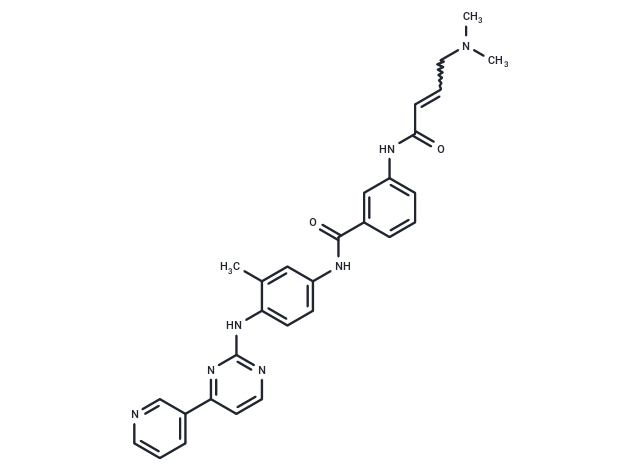Shopping Cart
Remove All Your shopping cart is currently empty
Your shopping cart is currently empty
JNK-IN-8 (JNK Inhibitor XVI) is an irreversible JNK1/2/4 inhibitor (IC50: 4.7/18.7/1 nM) with over 10-fold selectivity compared to MNK2 and Fms, and no inhibition of Met, c-Kit, or PDGFRβ in the A375 cell line.

| Pack Size | Price | USA Warehouse | Global Warehouse | Quantity |
|---|---|---|---|---|
| 2 mg | $39 | In Stock | In Stock | |
| 5 mg | $70 | In Stock | In Stock | |
| 10 mg | $122 | In Stock | In Stock | |
| 25 mg | $218 | In Stock | In Stock | |
| 50 mg | $363 | In Stock | In Stock | |
| 100 mg | $536 | In Stock | In Stock | |
| 200 mg | $761 | In Stock | - | |
| 1 mL x 10 mM (in DMSO) | $79 | In Stock | In Stock |
| Description | JNK-IN-8 (JNK Inhibitor XVI) is an irreversible JNK1/2/4 inhibitor (IC50: 4.7/18.7/1 nM) with over 10-fold selectivity compared to MNK2 and Fms, and no inhibition of Met, c-Kit, or PDGFRβ in the A375 cell line. |
| Targets&IC50 | JNK2:18.7 nM, JNK1:4.7 nM, JNK:1 nM |
| In vivo | JNK-IN-8 (10 mM) effectively inhibits the phosphorylation of c-Jun stimulated by IL-1β in IL-1R cells. It displays significant selectivity for the 1,4-bis(phenylamino) and 1,3-aminobenzoic acid structural regions compared to imatinib, covalently binding to the Cys154 target via an N,N-dimethylbutenamide linkage. JNK-IN-8 inhibits the phosphorylation of c-Jun in HeLa (EC50: 486 nM) and A375 (EC50: 338 nM) cells. Its binding with PIK3C3, IRAK1, PIP5K3, and PIP4K2C significantly enhances selectivity and elimination rates. JNK-IN-8 inhibits JNK2 through Cys116. |
| Kinase Assay | A375 cells are pre-treated with 1 μM JNK-IN-8 for the indicated amounts of time. Remove the medium and wash 3 times with PBS. Resuspend the cell pellet with 1 mL Lysis Buffer (1% NP-40, 1% CHAPS, 25 mM Tris, 150 mM NaCl, Phosphatase Inhibitor Cocktail, and Protease Inhibitor Cocktail). Rotate end-to-end for 30 min at 4°C. Lysates are cleared by centrifugation at 14000 rpm for 15 min in the Eppendorf. The cleared lysates gel filtered into Kinase Buffer (0.1% NP-40, 20 mM HEPES, 150 mM NaCl, Phosphatase Inhibitor Cocktail, Protease Inhibitor Cocktail) using Bio-Rad 10DG colums. The total protein concentration of the gel-filtered lysate should be around 5-15 mg/mL. Cell lysate is labeled with the probe from ActivX at 5 μM for 1 hour. Samples are reduced with DTT, and cysteines are blocked with iodoacetamide and gel filtered to remove excess reagents and exchange the buffer. Add 1 volume of 2X Binding Buffer (2% Triton-100, 1% NP-40, 2 mM EDTA, 2X PBS) and 50 μL streptavidin bead slurry and rotate end-to-end for 2 hours, centrifuge at 7000 rpm for 2 min. Wash 3 times with 1X Binding Buffer and 3 times with PBS. Add 30 μL 1X sample buffer to beads, heat samples at 95°C for 10 min. Run samples on an SDS-PAGE gel at 110V. After transferred, the membrane is immunoblotted with JNK antibody[1]. |
| Cell Research | JNK-IN-8 is dissolved in DMSO and stored, and then diluted with appropriate media before use[1]. HEK-293 cells stably expressing Interleukin Receptor 1 (HEK293-IL1R) are cultured in Dulbecco's Modified Eagle's medium (DMEM) supplemented with 10% FBS, 2 mM glutamine and 1×antimycotic/antibiotic solution. Cells are serum starved for 18 h before incubation with DMSO or JNK-IN-8, stimulated with 2 μM Anisomycin for 1h and lysates are clarified by centrifugation for 10 min at 16000 g and 4°C[1]. |
| Synonyms | JNK Inhibitor XVI |
| Molecular Weight | 507.59 |
| Formula | C29H29N7O2 |
| Cas No. | 1410880-22-6 |
| Smiles | CN(C)CC=CC(=O)Nc1cccc(c1)C(=O)Nc1ccc(Nc2nccc(n2)-c2cccnc2)c(C)c1 |
| Relative Density. | 1.283 g/cm3 (Predicted) |
| Color | White |
| Appearance | Solid |
| Storage | Powder: -20°C for 3 years | In solvent: -80°C for 1 year | Shipping with blue ice/Shipping at ambient temperature. | |||||||||||||||||||||||||||||||||||
| Solubility Information | DMSO: 56 mg/mL (110.33 mM), Sonication is recommended. H2O: < 1 mg/mL (insoluble or slightly soluble) Ethanol: < 1 mg/mL (insoluble or slightly soluble) | |||||||||||||||||||||||||||||||||||
| In Vivo Formulation | 10% DMSO+40% PEG300+5% Tween 80+45% Saline: 2 mg/mL (3.94 mM), Sonication is recommended. Please add the solvents sequentially, clarifying the solution as much as possible before adding the next one. Dissolve by heating and/or sonication if necessary. Working solution is recommended to be prepared and used immediately. The formulation provided above is for reference purposes only. In vivo formulations may vary and should be modified based on specific experimental conditions. | |||||||||||||||||||||||||||||||||||
Solution Preparation Table | ||||||||||||||||||||||||||||||||||||
DMSO
| ||||||||||||||||||||||||||||||||||||
| Size | Quantity | Unit Price | Amount | Operation |
|---|

Copyright © 2015-2026 TargetMol Chemicals Inc. All Rights Reserved.